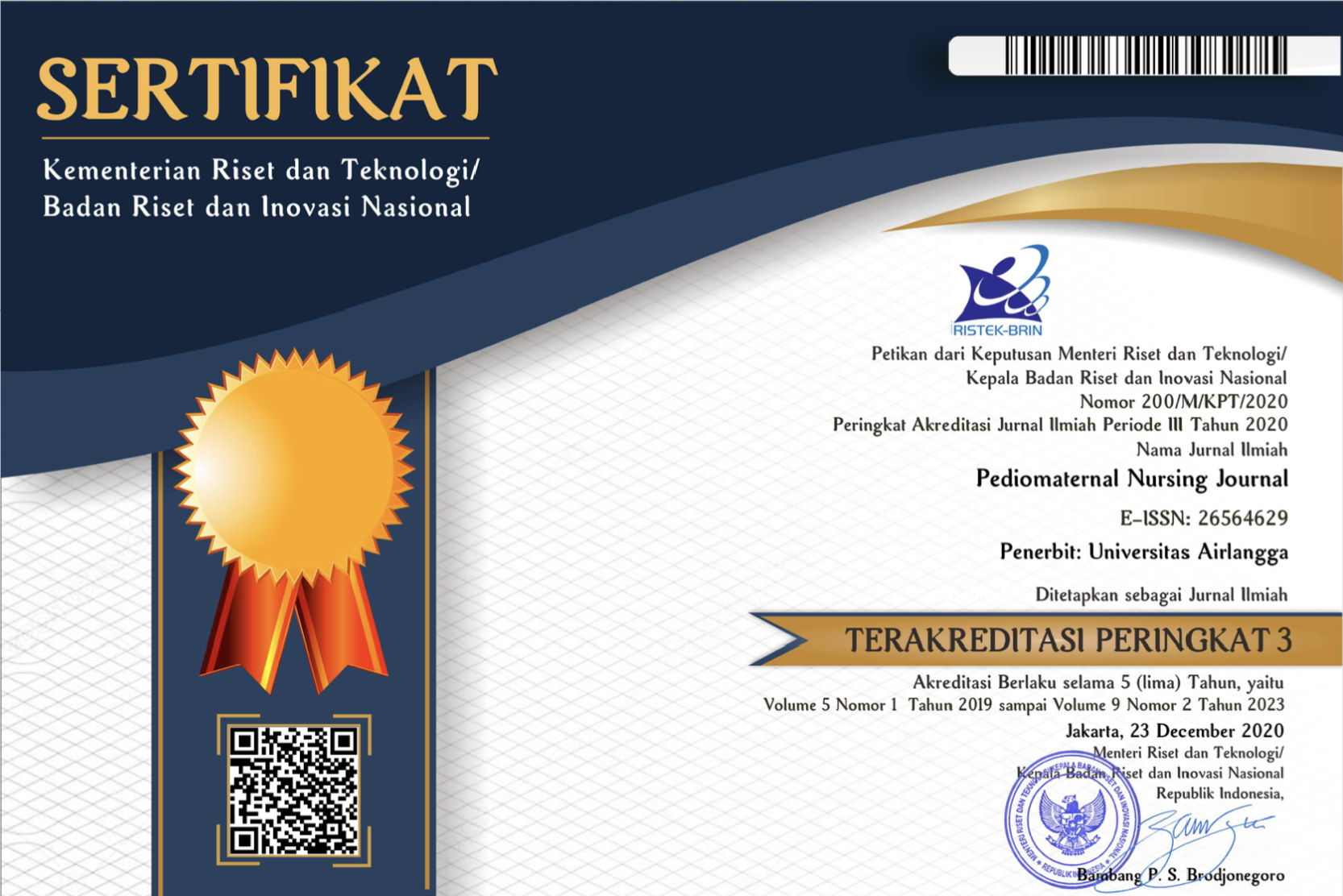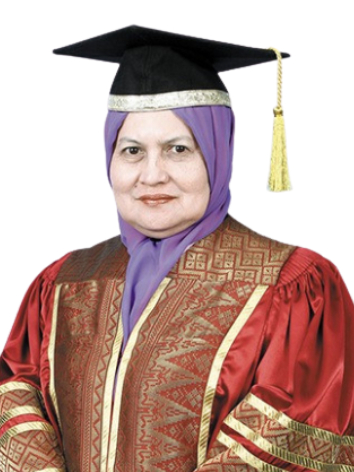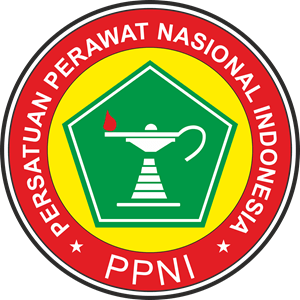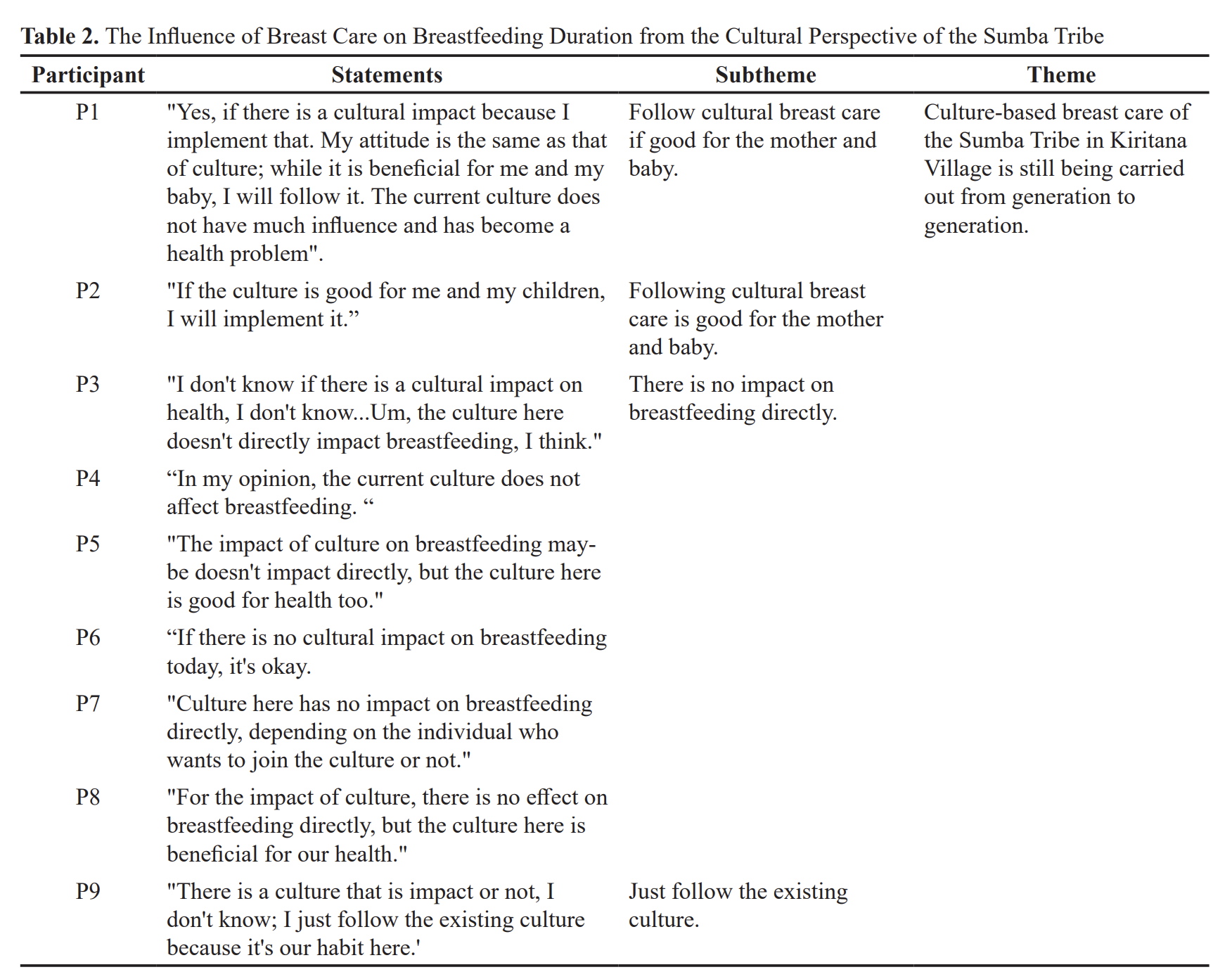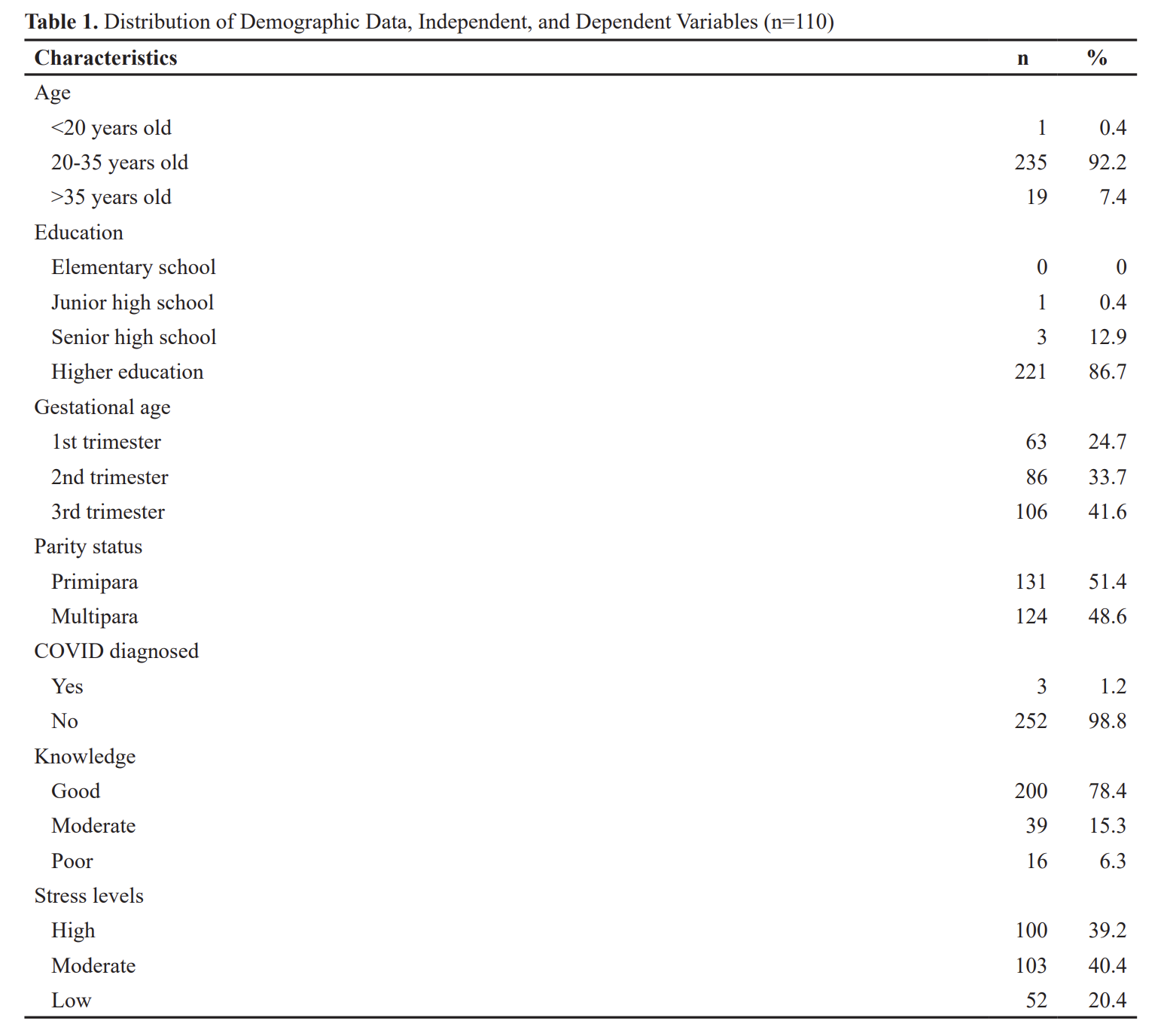The Relationship of Family Centered Care Implementation with Mother's Stress and Satisfaction with Services in The Edelweiss Room (Perinatology) at Regional Hospital of Balung Jember District
Downloads
Introduction: Neonatal intensive care causes high maternal stress, and low interaction between mother and baby are suspected to be a stressor. The role of the mother needed to participate in neonatal care. However, mothers want to monitor the condition of neonates during treatment. This purpose of study to analyze the correlation between family center care, stress and maternal satisfaction in the Edelweiss (Perinatology) at RSD Balung Jember.
Methods: A cross-sectional study was conducted among 124 post partum mothers whose babies were treated in the perinatology room with consecutive random sampling. Family center care, stress, and maternal satisfaction questionnaires were used. A Chi-square test was used to analyze to answer the research
Results: The results among respondents had high levels of family centered care implementation (63.7%), low maternal stress (51.6%), and high levels of maternal satisfaction (58.1%). There is a correlation between between family centered care implementation with maternal stress (X2 = 8.14; p-value = 0.004), and stress with maternal satisfaction (X2 = 19.3; p-value = 0.00). Mothers with high levels of family centered care implementation will prevent 0.2 times experiencing stress (OR = 0.16; 95% CI = 0.07-0.38), and if maternal satisfaction is high then 3 times will tend to have low stress (OR = 2.89; 95% CI = 1.38-6.06). However, there isn't correlation between family centered care implementation and satisfaction mother (X2 = 0.83; p-value = 0.36). Perhaps, maternal characteristics to be a factor.
Conculusion: Family center care services can meet the needs of parents and improve the quality of nursing care in the perinatology room for babies, parents and families so as to increase satisfaction with the services provided.
Bastani, F., Abadi, T. A., & Haghani, H. (2015). Effect of family-centered care on improving parental satisfaction and reducing readmission among premature infants: A randomized controlled trial. Journal Of Clinical & Diagnostic Research, 9(1), 4-8. doi:10.7860/JCDR/2015/10356.5444.
Butt, M. L., McGrath, J. M., Samra, H. A., & Gupta, R. (2013). An integrative review of parent satisfaction with care provided in the neonatal intensive care unit. Journal of Obstetric, Gynecologic, & Neonatal Nursing, 42(1), 105-120.
Chen, S. et al. (2017) ‘The prevalence and risk factors of preterm small-for-gestational-age infants: A population-based retrospective cohort study in rural Chinese population', BMC Pregnancy and Childbirth. BMC Pregnancy and Childbirth, 17(1), pp. 1–8. doi: 10.1186/s12884-017-1412-7.
Dary, Tampubolon, R. and Porsisa, P. G. (2019) ‘Family Centered Care pada Bayi Baru Lahir yang Dirawat di Ruang Neonatal Intensive Care Unit RSUD Dr. M. Haulussy Ambon', Jurnal Ilmu Keperawatan dan Kebidanan, 10(2), pp. 398–407.
Erlinda, V. (2015) ‘Penerapan model family-centered nursing terhadap pelaksanaan tugas kesehatan keluarga dalam pencegahan ISPA pada Balita di Wilayah Kerja Puskesmas Simpang Tiga Kabupaten Aceh Besar', Jurnal Kedokteran Yarsi, 23(2), pp. 165–186.
Hartiningrum, I. and Fitriyah, N. (2019) ‘Bayi Berat Lahir Rendah (BBLR) di Provinsi Jawa Timur Tahun 2012-2016', Jurnal Biometrika dan Kependudukan, 7(2), p. 97. doi: 10.20473/jbk.v7i2.2018.97-104.
Hodikoh, A. and Setyowati (2015) ‘Kemampuan merawat pada ibu pascaseksio sesarea dan hubungannya dengan nilai budaya', Ners, 10 No.2 Ok(1), pp. 348–354.
Ilham, M. et al. (2018) ‘Gynaecology and Perinatology Outcome Lupus Nephritis in Pregnancy at Dr . Soetomo Hospital , Indonesia', Gynaecology and Perinatalogy, 1(2), pp. 120–129.
Ivones, J & Rofii, M. (2013) ‘Pengalaman Ibu yang Memiliki Bayi Preterm yang Dirawat di Inkubator Rumah Sakit', Jurnal Keperawatan Anak, 1(1), pp. 10–17.
Julianti, E., Waluyanti, F. T. and Allenidekania (2018) ‘Kepuasan orangtua terhadap pelayanan keperawatan di ruang perinatologi', Indonesian Journal of Nursing Research (IJNR), 1(2), pp. 51–55.
Kawafha, M. M. (2018) ‘Parental stress in the neonate intensive care unit and its association with parental and infant characteristics', Journal of Neonatal Nursing, 24(5), pp. 266–272. doi: 10.1016/j.jnn.2018.05.005.
Kegler, J. J. et al. (2019) ‘Stress in Parents of Newborns in a Neonatal Intensive Care Unit', Escola Anna Nery, 23(1), pp. 1–6. doi: 10.1590/2177-9465-ean-2018-0178.
Kemenkes, R. (2016) ‘Standar Pelayanan Keperawatan Neonatus di Rumah Sakit', pp. 1–57.
Khayati, Y. N. and Sundari, S. (2019) ‘Hubungan Berat Badan Lahir Dengan Pertumbuhan Dan Perkembangan', Indonesian Journal of Midwifery (IJM), 2(2), pp. 58–117. doi: 10.35473/ijm.v2i2.266.
Kusuma, N. (2016) ‘Hubungan antara metode dan lama pemakaian dengan keluhan kesehatan subyektif pada akseptor', Jurnal Berkala Epidemiologi, 4(2), pp. 164–175. doi: 10.20473/jbe.v4i2.2016.164.
Ludyanti, L. N., Rustina, Y. and Afiyanti, Y. (2015) ‘Pengalaman Orang Tua Menerima Perilaku Caring Perawat dalam Memfasilitasi Bonding Attachment Bayi Prematur', Jurnal Keperawatan Indonesia, 18(3), pp. 181–187. doi: 10.7454/jki.v18i3.438.
Maulidia, R., Ugrasena, D. I. D. G. and Sufyanti, Y. (2016) ‘Penurunan kecemasan dan koping orang tua dalam merawat anak yang mengalami hospitalisasi melalui penerapan', Jurnal Hesti Wira Sakti, 4(1), pp. 58–73. Available at: https://jurnal.poltekkes-soepraoen.ac.id/index.php/HWS/article/view/123.
Mbana, I. M., Yunitasari, E. and Armini, N. ketut A. (2019) ‘Analisis Faktor Perilaku Seks Pranikah Remaja Berdasarkan Teori Transcultural Nursing di Kabupaten Sumba Timur', Pediomaternal Nursing Journal, 5(1), p. 124. doi: 10.20473/pmnj.v5i1.13207.
Mohamed, H. S., Abd, E. and Mohamed, E. (2019) ‘Stress Among Mothers of Hospitalized Children at Qena Governorate Stress Among Mothers of Hospitalized Children at Qena Governorate', (January).
Musabirema, P., Brysiewicz, P. and Chipps, J. (2015) ‘Parents perceptions of stress in a neonatal intensive care unit in Rwanda', Curationis, 38(2), p. 1499. doi: 10.4102/curationis.v38i2.1499.
Nurhidayah Ai; Fitri, Siti Yuyun Rahayu; Fatimah, Sari; Hendrawati, Sri, I. M. (2018) ‘Needs of Parents in Critically Ill Infants Care in the Neonatal Intensive Care Unit (Nicu)', Jurnal Keperawatan, 9(Vol 9, No 1 (2018): JANUARI), pp. 43–57. Available at: http://ejournal.umm.ac.id/index.php/keperawatan/article/view/4651.
Palma I., E. et al. (2017) ‘Estrés en padres de recién nacidos hospitalizados en una unidad de paciente critic neonatal', Revista Chilena de Pediatria, 88(3), pp. 332–339. doi: 10.4067/S0370-41062017000300004.
Rahayu, S. and Nurhayati, I. A. (2016) ‘Faktor Yang Mempengaruhi Tingkat Stres Orang Tua Pada Berat Badan Lahir Rendah (Bblr)', Jurnal Keperawatan Global, 1(2), pp. 87–93.
Rakhmadi, D., Hariyanto, T. and Sulasmini (2018) ‘Perbedaan Lama Hari Rawat Inap Pasien Pneumonia dengan Non Pneumonia di Ruang Perawatan Anak Rumah Sakit Umum Daerah Kotabaru', Nursing News, 3, pp. 550–556. Available at: https://publikasi.unitri.ac.id/index.php/fikes/article/view/1387/972.
Ratnasari, D., Suhartono, S. and Rahfiludin, M. Z. (2017) ‘Faktor Risiko Kejadian Berat Badan Lahir Rendah di Area Pertanian (Studi di Kabupaten Brebes)', Jurnal Gizi dan Pangan, 12(1), pp. 41–48. doi: 10.25182/jgp.2017.12.1.41-48.
Susilowati, E., Wilar, R. and Salendu, P. (2016) ‘Faktor risiko yang berhubungan dengan kejadian berat badan lahir rendah pada neonatus yang dirawat di RSUP Prof. Dr. R. D. Kandou periode Januari 2015-Juli 2016', e-CliniC, 4(2). doi: 10.35790/ecl.4.2.2016.14468.
Tanaem, G. H., Dary, M. and Istiarti, E. (2019) ‘Family Centered Care Pada Perawatan Anak Di Rsud Soe Timor Tengah Selatan', Jurnal Riset Kesehatan, 8(1), p. 21. doi: 10.31983/jrk.v8i1.3918.
Wormald, F. et al. (2015) ‘Stress in parents of very low birth weight preterm infants hospitalized in neonatal intensive care units. A multicenter study', Archivos Argentinos de Pediatria, 113(4), pp. 303–309. doi: 10.5546/aap.2015.eng.303.
Copyright (c) 2022 Ira Rahmawati, Istna Abidah Mardiyah, Ami ‘Alaili Wahidah

This work is licensed under a Creative Commons Attribution 4.0 International License.
1. The journal allows the author to hold the copyright of the article without restrictions.
2. The journal allows the author(s) to retain publishing rights without restrictions.
3. The legal formal aspect of journal publication accessibility refers to Creative Commons Attribution (CC BY).

